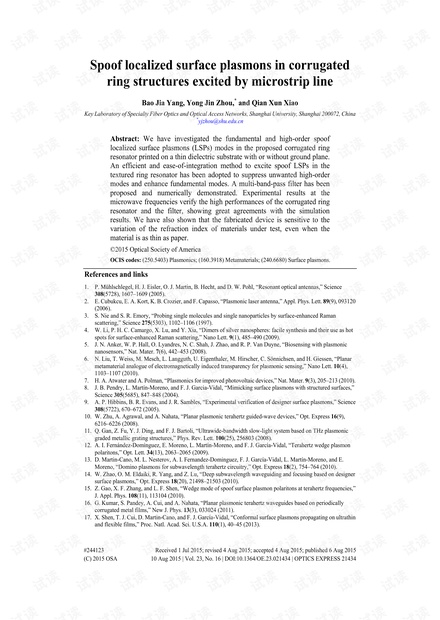
18. X. Gao, L. Zhou, Z. Liao, H. F. Ma, and T. J. Cui, “An ultra-wideband surface plasmonic filter in microwave
frequency,” Appl. Phys. Lett. 104(19), 191603 (2014).
19. H. F. Ma, X. Shen, Q. Cheng, W. X. Jiang, and T. J. Cui, “Broadband and high efficiency conversion from guided
waves to spoof surface plasmon polaritons,” Laser Photonics Rev. 8(1), 146–151 (2014).
20. J. J. Wu, J. Hou, K. Liu, L. Shen, C. A. Tsai, C. J. Wu, D. Tsai, and T. J. Yang, “Differential microstrip lines with
reduced crosstalk and common mode effect based on spoof surface plasmon polaritons,” Opt. Express 22(22),
26777–26787 (2014).
21. X. Liu, Y. Feng, B. Zhu, J. Zhao, and T. Jiang, “High-order modes of spoof surface plasmonic wave transmission
on thin metal film structure,” Opt. Express 21(25), 31155–31165 (2013).
22. Z. Liao, J. Zhao, B. C. Pan, X. P. Shen, and T. J. Cui, “Broadband transition between microstrip line and conformal
surface plasmon waveguide,” J. Phys. D Appl. Phys. 47(31), 315103 (2014).
23. R. Quesada, D. Martín-Cano, F. J. García-Vidal, and J. Bravo-Abad, “Deep-subwavelength negative-index
waveguiding enabled by coupled conformal surface plasmons,” Opt. Lett. 39(10), 2990–2993 (2014).
24. I. R. Hooper, B. Tremain, J. A. Dockrey, and A. P. Hibbins, “Massively sub-wavelength guiding of
electromagnetic waves,” Sci. Rep. 4, 7495 (2014).
25. H. C. Zhang, S. Liu, X. P. Shen, L. H. Chen, L. M. Li, and T. J. Cui, “Broadband amplification of spoof surface
plasmon polaritons at microwave frequencies,” Laser Photonics Rev. 9(1), 83–90 (2015).
26. A. Pors, E. Moreno, L. Martín-Moreno, J. B. Pendry, and F. J. García-Vidal, “Localized spoof plasmons arise
while texturing closed surfaces,” Phys. Rev. Lett. 108(22), 223905 (2012).
27. Z. Li, L. L. Liu, C. Q. Gu, P. P. Ning, B. Z. Xu, Z. Y. Niu, and Y. J. Zhao, “Multi-band localized spoof plasmons
with texturing closed surfaces,” Appl. Phys. Lett. 104(10), 101603 (2014).
28. P. A. Huidobro, X. P. Shen, J. Cuerda, E. Moreno, L. Martin-Moreno, F. J. Garcia-Vidal, T. J. Cui, and J. B.
Pendry, “Magnetic localized surface plasmons,” Phys. Rev. X 4(2), 021003 (2014).
29. X. P. Shen and T. J. Cui, “Ultrathin plasmonic metamaterial for spoof localized surface plasmons,” Laser
Photonics Rev. 8(1), 137–145 (2014).
30. Z. Liao, Y. Luo, A. I. Fernández-Domínguez, X. Shen, S. A. Maier, and T. J. Cui, “High-order localized spoof
surface plasmon resonances and experimental verifications,” Sci. Rep. 5, 9590 (2015).
31. Z. Liao, X. P. Shen, B. C. Pan, J. Zhao, Y. Luo, and T. J. Cui, “Combined system for efficient excitation and
capture of LSP resonances and flexible control of SPP transmissions,” ACS Photonics 2(6), 738–743 (2015).
32. F. Gao, Z. Gao, Y. M. Zhang, X. H. Shi, Z. J. Yang, and B. L. Zhang, “Vertical transport of subwavelength
localized surface electromagnetic modes,” Laser Photonics Rev. (posted 20 July 2015).
33. X. Liu, Y. Feng, K. Chen, B. Zhu, J. Zhao, and T. Jiang, “Planar surface plasmonic waveguide devices based on
symmetric corrugated thin film structures,” Opt. Express 22(17), 20107–20116 (2014).
34. F. Gao, Z. Gao, X. Shi, Z. Yang, X. Lin, and B. Zhang, “Dispersion-tunable designer-plasmonic resonator with
enhanced high-order resonances,” Opt. Express 23(5), 6896–6902 (2015).
35. B. Shuppert, “Microstrip/slotline transitions: modeling and experimental investigation,” IEEE Trans. Microw.
Theory Tech. 36(
8
), 1272–1282 (1988).
36. K. C. Gupta, R. Garg, and P. Bhartia, Microstrip Lines and Slotlines (Artech House, 1996).
37. X. G. Huang, Q. Y. Feng, and Q. Y. Xiang, “High selectivity broadband bandpass filter using stub-loaded
quadruple-mode resonator,” J. Electromagnet. Wave. 26(1), 34–43 (2012).
1. Introduction
Localized surface plasmons (LSPs) on small metal particles have been of interest for increasing
applications in the optical antenna [1,2], surface-enhanced Raman scattering [3,4], chemical
and biological sensors [5,6], and photovoltaic [7], etc. In order to realize highly confined
propagating surface electromagnetic (EM) waves at the microwave and terahertz (THz)
frequencies, spoof (or designer) SPs on the textured metal surfaces were proposed and verified
[8,9], paving the way to realize spoof (designer) plasmonic waveguides and components
[10–16]. Conformal SPs (CSPs) waveguides based on ultrathin corrugated metal strips have
been demonstrated [17], leading to various ultrathin microwave and THz plasmonic functional
devices [18–25]. A pioneering study on spoof LSPs has been conducted to show that a two
dimensional (2D) periodically textured metallic cylinder was able to support spoof LSPs [26].
It’s been shown that a periodically textured closed cavity can also support spoof LSPs [27].
Magnetic LSPs supported by cylindrical structures were then theoretically and experimentally
explored [28]. Recently, the spoof LSPs on the ultrathin textured metallic disk were
demonstrated experimentally at microwave frequencies [29]. Compared to long cylinders [26],
it is easy to observe lower plasmonic resonances (dipole and quadrupole modes) on the
ultrathin textured disk. High-order spoof LSPs in periodically corrugated metal particles were
also theoretically and experimentally investigated, showing these modes resemble the optical
whispering gallery modes sustained by dielectric resonators [30]. It has been illustrated that
Received 1 Jul 2015; revised 4 Aug 2015; accepted 4 Aug 2015; published 6 Aug 2015
10 Aug 2015 | Vol. 23, No. 16 | DOI:10.1364/OE.23.021434 | OPTICS EXPRESS 21435




 我的内容管理
展开
我的内容管理
展开
 我的资源
快来上传第一个资源
我的资源
快来上传第一个资源
 我的收益 登录查看自己的收益
我的收益 登录查看自己的收益 我的积分
登录查看自己的积分
我的积分
登录查看自己的积分
 我的C币
登录后查看C币余额
我的C币
登录后查看C币余额
 我的收藏
我的收藏  我的下载
我的下载  下载帮助
下载帮助 
 前往需求广场,查看用户热搜
前往需求广场,查看用户热搜

 信息提交成功
信息提交成功